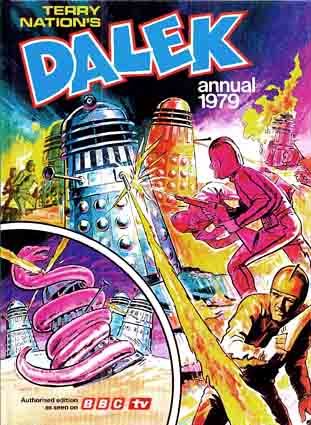The 1979 Dalek Annual

|
|
World Distributors The 1979 Dalek Annual |

|
| Published | 1978 |  |
| SBN | 7235 0490 3 |
| Starring Joel Shaw, Reb Shavron, Mark Seven and the Daleks |
A Review by Finn Clark 1/6/04
The best seventies Dalek annual - and that's saying something.
I didn't remember much about these World Distributors annuals while rereading them... perhaps a few random childhood memories, but basically I came to 'em fresh. Not the case with Blockade. Even after fifteen years, this story is still burned into my brain. In it a selfish git called Ed Cowley is ambushed by Daleks, dives into a black hole, gets transformed by what he finds inside and ends up mounting a one-man suicide blockade to save the universe from the Daleks that followed him. He fails of course, but what did you expect in a Dalek annual? You didn't think the humans could win?
Oh, and some of the illustrations show Ed Cowley being played by William Hartnell! That's weird.
The Solution might be the most chilling Dalek story ever. It's certainly bleaker than anything else from these seventies Dalek annuals, despite stiff competition. The Daleks have invaded Scottus, but the Scottians have a secret weapon. So far, nothing out of the ordinary. But what this secret weapon is, and what it deems necessary... brrrr.
Finally there's The Planet That Cried "Wolf!", the weakest story in the book because it's "merely" very good. The ADF get lured to a prison planet inhabited by utter bastards, as hard-edged and brutal as you'd expect from a story set in Terry Nation's universe. We've seen similar stories told a hundred times, but it's the intensity of Zarg's psychopathic malevolence that makes this one memorable. It feels real. His death scene is a show-stopper and the story's not far from being a classic too.
The filler articles are practically lifted from 1964's Dalek Book. This 1979 Anatomy of a Dalek is simpler than its 1964 predecessor, but see the continuity in the details. One example: a Dalek's outer casing is made of Dalekenium. Hardly conclusive, I hear you cry. True, yes, but both books agree that Dalekenium is ten times stronger than steel and a quarter of the weight of aluminium.
The Dalography of Skaro is identical to the 1964 one. The map is a painted satellite image rather than a black-and-red faux atlas, but otherwise they have no point of deviation. The continents, the rivers, the oceans, the mountain ranges... all have the same positions, the same names and the same exotic properties. The 1979 illustration implies that we're only seeing a small part of the planet, but that's accurate too. Since the 1964 Dalography came with a scale factor (1:150,700,000) and we learned Skaro's size in 1966, we can do some mathematics. The Dalography seems to show about a billion square kilometres, i.e. a third of Skaro's surface area (but twice as much as Earth's). Any of Skaro's continents has more land than all the continents on Earth put together!
Finally there's the Dalek Dictionary, again lifted from its 1964 equivalent. On first glance this looks like random nonsense, but I was amazed. Some of its words are from the 1964 Dictionary, but others refer to obscure nuggets of sixties Dalek continuity. Remember the eight-armed Octovarns from the planet Varnicon? Nope, didn't think so, but the writer of this filler article did. (They're from The Dalek World, by the way.)
All these bits of information over the years... they weren't just
random throwaways. Terry Nation filed them away to make a bigger picture.
Suddenly I want to read The Dalek Pocketbook (a sixties paperback
which treated the Daleks as real, like the recent
The comic strips are the book's weak point, which is proof of the
general high standard. How many annuals have been able to say that?
Walter Howarth is the artist, previously seen drawing Hartnell annuals,
and I'm not wild about his watery colouring. It tells the story, but I
prefer the vibrant palette of a Paul Crompton or a Ron Turner. Apart from
anything else, there's clumsy balloon placement and the space battles look
stupid. However the scripts (The Human Bombs and Island of
Terror) are okay, with The Human Bombs having a sadistic ending
that could have come from an EC horror comic. I enjoyed them. However
they're not seared into my memory like the text stories.
These annuals have sent my respect for Terry Nation through the roof.
Conventional fannish wisdom paints him as a formulaic hack, with Planet somehow regarded as the "real Terry" and Genesis as the aberration. However if he wrote these
annuals (and they certainly bear his hallmarks), I think I disagree.
Terry Nation wrote best from the gut, telling primal stories about raw
emotion and the fight for survival. There's nothing cosy about them.
Even in a frigging World Distributors annual, he can wring shock, fear and
emotional reactions from his readers.
The commitment of Hinchcliffe and Holmes was what Terry Nation
needed. At that intensity level, the man's work is bloody
powerful. Check out these annuals. Seriously.